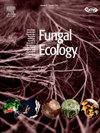Effects of fungicide application on the foliar endophytic fungi of Scots pine (Pinus sylvestris)
IF 2.2
3区 环境科学与生态学
Q3 ECOLOGY
引用次数: 0
Abstract
Following fungicide treatment of young Scots pine trees in Scotland targeted at Dothistroma septosporum, foliar fungal endophytic communities were investigated with culture-based methods and metabarcoding of cDNA. Compared to negative controls, application of fungicides resulted in significant reductions in the size and diversity of endophytic communities with alterations to their taxonomic composition. While most taxa showed reductions in frequency and abundance across samples, Anthostomella pinea and a Preussia sp. temporarily increased. Thirteen taxa were identified using culturing, compared to 569 by metabarcoding (with 41 taxa accounting for 89.4 % of the total reads). Dothistroma septosporum and the reportedly unculturable Lophodermella conjuncta both contributed significantly to differences observed using metabarcoding but occurred at low levels or were absent, respectively, in the culture-based study. The persistent effects we observed of fungicides on the endophytic fungal community have possible practical implications for management of tree seedlings in the nursery.
杀菌剂对苏格兰松叶面内生真菌的影响
在对苏格兰幼松进行杀菌剂处理后,采用基于培养的方法和cDNA元条形码技术对其叶面真菌内生群落进行了研究。与阴性对照相比,施用杀菌剂导致内生菌群落的大小和多样性显著减少,并改变了它们的分类组成。虽然大多数分类群的频率和丰度在整个样本中都有所下降,但菠萝anththostomella pinea和a Preussia sp.暂时增加。通过培养鉴定出13个分类群,元条形码鉴定出569个分类群(其中41个分类群占总reads的89.4%)。使用元条形码观察到,Dothistroma septosporum和据报道不可培养的Lophodermella conjuncta都对差异有显著贡献,但在基于培养的研究中,它们的水平很低或不存在。我们观察到的杀菌剂对内生真菌群落的持续影响可能对苗圃中树苗的管理具有实际意义。
本文章由计算机程序翻译,如有差异,请以英文原文为准。
求助全文
约1分钟内获得全文
求助全文
来源期刊

Fungal Ecology
环境科学-生态学
CiteScore
5.80
自引率
3.40%
发文量
51
审稿时长
3 months
期刊介绍:
Fungal Ecology publishes investigations into all aspects of fungal ecology, including the following (not exclusive): population dynamics; adaptation; evolution; role in ecosystem functioning, nutrient cycling, decomposition, carbon allocation; ecophysiology; intra- and inter-specific mycelial interactions, fungus-plant (pathogens, mycorrhizas, lichens, endophytes), fungus-invertebrate and fungus-microbe interaction; genomics and (evolutionary) genetics; conservation and biodiversity; remote sensing; bioremediation and biodegradation; quantitative and computational aspects - modelling, indicators, complexity, informatics. The usual prerequisites for publication will be originality, clarity, and significance as relevant to a better understanding of the ecology of fungi.
 求助内容:
求助内容: 应助结果提醒方式:
应助结果提醒方式:


